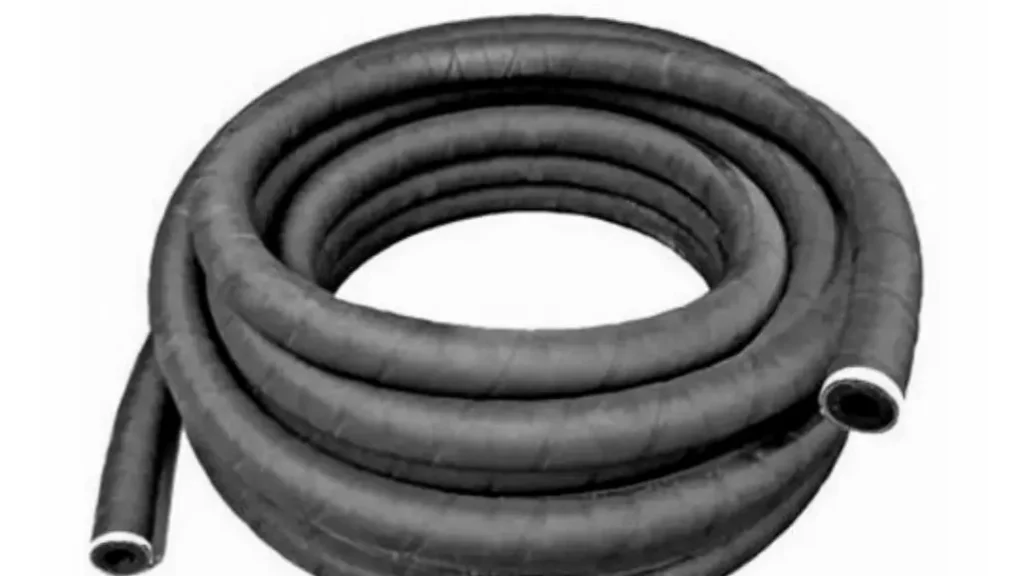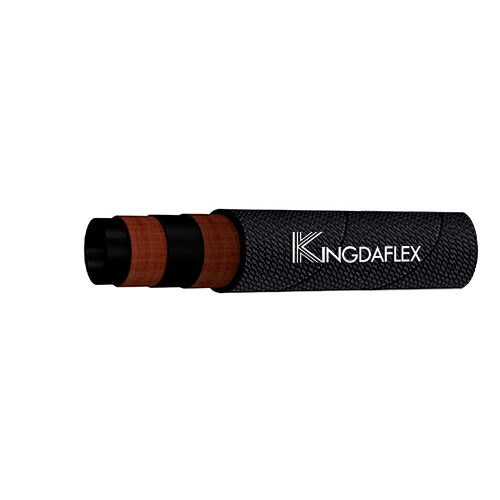Are you looking to invest in the perfect sandblasting hose for your project? Choosing the right hose size is crucial for efficient and safe sandblasting.
This comprehensive guide will help you understand the factors influencing hose size selection and provide valuable tips for optimal performance.
What Is Sandblasting Hose

Sandblasting hose is a specialized type of hose designed to withstand the abrasive nature of sandblasting. It is typically made from high-strength materials, such as rubber or synthetic polymers, to resist wear and tear caused by the constant bombardment of sand particles.
These hoses are used to transport a mixture of compressed air and abrasive material (like sand, glass beads, or metal grit) to a sandblasting gun. The mixture is then forced out of the gun at high pressure, removing surface contaminants and creating a smooth finish on various materials.
Key characteristics of sandblasting hose:
- Durability: Resistant to abrasion, cuts, and punctures.
- Flexibility: Allows for easy maneuverability in different work environments.
- Pressure resistance: Can handle high-pressure air and abrasive materials.
- Chemical resistance: May be resistant to certain chemicals used in sandblasting processes.
- Temperature resistance: Can withstand a wide range of temperatures.
Common applications for sandblasting hose:
- Industrial manufacturing (e.g., automotive, aerospace, shipbuilding)
- Construction (e.g., surface preparation for painting or coating)
- Restoration (e.g., restoring antique or vintage items)
- Art and crafts (e.g., creating unique textures on surfaces)
Would you like to learn more about the different types of sandblasting hose or how to choose the right size for your specific needs?
Abrasive Blasting Hose Size
Here is the blasting hose size chart for your conference.
| Air Consumption (CFM) per Blast Nozzle Using Abrasive | ||||||||||||
Nozzle Size | Nozzle Pressure | |||||||||||
| 50 psi | 60 psi | 70 psi | 80 psi | 90 psi | 100 psi | 110 psi | 120 psi* | 130 psi* | 140 psi* | 150 psi* | ||
| No. 2 | ⅛” | 14 | 17 | 19 | 21 | 24 | 26 | 28 | 30 | 32 | 34 | 37 |
| No. 3 | ³/₁₆” | 32 | 37 | 42 | 47 | 52 | 57 | 62 | 67 | 72 | 77 | 83 |
| No. 4 | 1/4” | 57 | 66 | 75 | 84 | 93 | 103 | 111 | 119 | 127 | 136 | 185 |
| No. 5 | ⁵/₁₆” | 89 | 103 | 117 | 131 | 145 | 158 | 172 | 186 | 200 | 214 | 229 |
| No. 6 | ⅜” | 129 | 149 | 169 | 189 | 209 | 229 | 249 | 269 | 289 | 309 | 330 |
| No. 7 | ⁷/₁₆” | 176 | 203 | 230 | 258 | 285 | 312 | 339 | 367 | 394 | 422 | 451 |
| No. 8 | 1/2” | 229 | 265 | 300 | 336 | 371 | 407 | 442 | 478 | 513 | 549 | 586 |
| No. 10 | ⅝” | 356 | 412 | 468 | 524 | 580 | 632 | 688 | 744 | 800 | 856 | 914 |
| No. 12 | ¾” | 516 | 596 | 676 | 756 | 836 | 916 | 996 | 1076 | 1156 | 1236 | 1318 |
| EFFICIENCY | 47% | 55% | 64% | 74% | 86% | 100% | 115% | 130% | 145% | 165% | 175% | |
Ensure your sandblasting equipment is rated for these pressures.
| Nozzle Pressure vs Efficiency | ||
| Blast Nozzle Pressure | Approximate Abrasive Velocity | Approximate Efficiency Factor |
| 100 psi | 675 kph (422 mph) | 100% |
| 95 psi | 640 kph (400 mph) | 93% |
| 90 psi | 585 kph (366 mph) | 86% |
| 85 psi | 530 kph (331 mph) | 80% |
| 80 psi | 495 kph (309 mph) | 74% |
| 75 psi | 450 kph (281 mph) | 69% |
| 70 psi | 420 kph (263 mph) | 64% |
| Sandblasting Hose Selection Guide for Blasting at 100 psi Nozzle Pressure | |||||
| Nozzle Number | No. 4 | No. 5 | No. 6 | No. 7 | No. 8 |
| Nozzle Size | 1/4” (6 mm) | 5/16” (8 mm) | 3/8” (10 mm) | 7/16” (11 mm) | 1/2” (13 mm) |
| CFM at 100 psi | 103 | 158 | 229 | 312 | 407 |
| Air Hose ID – minimum | 25 mm (1”) | 38 mm (1 1/2”) | 38 mm (1 1/2”) | 50 mm (2”) | 50 mm (2”) |
| Blast Hose ID – minimum | 20 mm (¾”) | 25 mm (1”) | 32 mm (1 1/4”) | 32 mm (1 1/4”) | 38 mm (1 1/2”) |
| Typical ID – OD Relationship in Common Sandblast Hose | |||||||
| Standard Hose | Supa/Whip Hose | ||||||
| ID | OD | ID | OD | ||||
| mm | inch | mm | inch | mm | inch | mm | inch |
| 13 | 1/2” | 33 | 1 5/16” | 13 | 1/2” | 30 | 1 3/16” |
| 19 | ¾” | 40 | 1 1/2” | 19 | ¾” | 33 | 1 5/16” |
| 25 | 1 | 48 | 1 ⅞” | 25 | 1 | 40 | 1 1/2” |
| 32 | 1 1/4” | 55 | 1 5/32” | 32 | 1 1/4” | 48 | 1 ⅞” |
| 38 | 1 1/2” | 60 | 2 ⅜” | 38 | 1 1/2” | 55 | 2 5/32” |
| English USA Units/Metric Conversion Chart | |||
| 1 3/6” | 5 mm | 1 1/4” | 32 mm |
| 1/4” | 6 mm | 5/6” | 33 mm |
| 5/16” | 8 mm | 1-1/2” | 38 mm |
| 3/8” | 10 mm | 1 9/16” | 40 mm |
| 7/16” | 11 mm | 1 3/4” | 44 mm |
| 1/2” | 13 mm | 1 7/8” | 48 mm |
| 5/8” | 16 mm | 2” | 51 mm |
| 3/4” | 19 mm | 2 5/32” | 55 mm |
| 1” | 25 mm | 2 3/8” | 60 mm |
| 1 3/16” | 30 mm | 2 1/2” | 64 mm |
What Size Air Hose for Sandblasting

The ideal air hose size for sandblasting depends on several factors, including:
- Sandblasting gun type: Different guns have varying air requirements.
- Project size and complexity: Larger projects may require a larger hose.
- Distance between air compressor and work area: Longer distances necessitate a larger hose to minimize pressure loss.
- Abrasive material: Some abrasives require higher air pressure, which may necessitate a larger hose.
Common air hose sizes for sandblasting:
- 1/4 inch: Suitable for smaller projects and lighter-duty sandblasting guns.
- 3/8 inch: A versatile size for many sandblasting applications, offering a good balance of flow and portability.
- 1/2 inch: Recommended for larger projects, high-pressure applications, or long distances between the compressor and work area.
General guidelines:
- A 3/8 inch air hose is typically sufficient for most residential or small-scale projects.
- A 1/2 inch hose may be necessary for larger industrial applications or long distances.
- Always consult the manufacturer‘s recommendations for your specific sandblasting gun.
It’s important to avoid using a hose that is too small, as this can lead to:
- Reduced air pressure: Affecting the efficiency of the sandblasting process.
- Increased wear and tear on the hose: Shortening its lifespan.
By choosing the right air hose size, you can ensure optimal performance, efficiency, and safety during your sandblasting projects.
Sandblasting Hose Sizes for Different Applications

Removing Rust from a Ship
- Large-scale projects: When removing rust from a large ship, a 1/2 inch or even 3/4 inch hose is necessary to handle the high volume of air and abrasive material required for efficient cleaning. These larger hoses can deliver more powerful blasts, accelerating the rust removal process and ensuring thorough coverage of the entire ship’s surface.
- Considerations: Factors such as the ship’s size, the extent of rust damage, and the desired level of surface preparation will influence the optimal hose size. It’s also essential to consider the length of the hose, as longer hoses may experience pressure loss.
Cleaning Smaller Metal Objects
- Smaller objects: For cleaning smaller metal objects like tools or machinery parts, a 1/4 inch or 3/8 inch hose is typically sufficient. These smaller hoses are more maneuverable and easier to handle in confined spaces. They also provide a more controlled blast, making them suitable for delicate or intricate work.
- Considerations: The size and shape of the object, the type of rust or corrosion, and the desired level of surface finish will influence the appropriate hose size.
Removing Paint from Concrete
- Concrete removal: When removing paint from concrete surfaces, a 3/8 inch or 1/2 inch hose can be effective. These hoses provide a powerful blast that can efficiently strip away paint layers.
- Considerations: The thickness of the paint layer, the type of paint, and the condition of the concrete surface will influence the optimal hose size.
Sandblasting Glass or Ceramic
- Delicate materials: For more delicate materials like glass or ceramic, a 1/4 inch hose might be preferable to avoid excessive force that could damage the surface. A smaller hose provides a more controlled blast, reducing the risk of damaging the material.
- Considerations: The thickness and fragility of the glass or ceramic, the desired level of surface preparation, and the type of abrasive used will influence the appropriate hose size.
Remember to always consult the manufacturer‘s recommendations for your specific sandblasting gun and application. By selecting the appropriate hose size, you can ensure optimal performance, efficiency, and safety during your sandblasting projects.
Conclusion
Ready to invest in the perfect sandblasting hose for your project? Look no further than Kingdaflex, a leading provider of high-quality sandblasting hoses.
Visit our website today to explore our extensive range of hoses and find the ideal size and specifications to meet your specific needs.
Don’t compromise on quality or performance. Choose Kingdaflex for your sandblasting hose needs.


